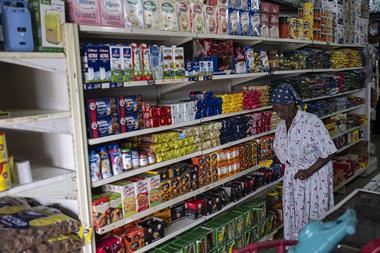Food testing methods inadequate, say analytical instrument makers
The Chinese government must invest in a systematic program of research to improve testing methods if it is to avoid further problems with food contamination, say analytical chemistry experts. Their calls come after milk powder contaminated with melamine sickened at least 54,000 babies, killed four in China through kidney stones, and made its way into chocolates and biscuits exported around the world.
Melamine, a nitrogen rich crystalline compound used to make plastics, fertilizers and cleaning products, was added by many Chinese dairies and distributors to inflate the protein content of their milk powder, with fatal results. Protein content – determined by measuring nitrogen concentration – is the standard measure of milk quality.
While the government's food safety watchdog found no traces of melamine in liquid milk during its round of tests in early October, industry experts say that testing methods for food contamination need to be better studied and updated to take advantage of the latest technology. And instrument makers have warned that current testing methods may be inadequate.
Analytical uncertainty
Wang Bing, CEO of Beijing Techmate, which represents Japanese cosmetics firm Shiseido's analysis wing in China, says that the methods currently being used to analyse milk may not detect other contaminants that might also be present.
This is important because the impure industrial melamine added to milk often contains a second compound, cyanuric acid. The two chemicals together can form insoluble crystals, which can lead to the formation of kidney stones and ultimately kidney failure. Melamine alone is less toxic – though prolonged exposure to the compound could also cause health problems.
In addition, Wang says, different technical approaches – such as liquid chromatography and gas chromatography – give quite different results when used to test for melamine. But so far there have been no efforts from either the government or academia to work out why. 'More systematic approaches must be adopted in food contamination tests,' Wang told Chemistry World.
Zhu Min of PerkinElmer, who is responsible for melamine analysis at the firm, says contamination testing should make better use of the latest technologies. 'Molecular analysis technologies have been mature for 10 years, yet nitrogen levels remain the sole measure used to determine milk's protein content,' Zhu says.
But the price tag attached to molecular analysis technology may be holding back its wider use. Bo Tao, an LC/MS application engineer at Agilent, says even the cheapest HPLC costs more than US$10,000 and the consumables needed to run the tests are also expensive.
Meanwhile, China's Ministry of Science and Technology posted a note on its website asking members of the public to submit testing methods able to identify the presence of melamine in under 30 minutes. According to media reports, the ministry had received more than 100 solutions by its 8 October deadline.
Research gap
The health implications of the melamine scandal remain uncertain. Though the compound is known to cause kidney stones in babies, no adult incidence of the problem has yet been reported – possibly because milk forms only a small part of the adult diet.
On 7 October, the Chinese government stipulated that milk powder should contain no more than 1mg of melamine per kilogram (approximately 1 part per million).
But the US Food and Drug Administration (FDA) said on 3 October that it is unable to establish any 'safe' level of melamine and melamine-related compounds in infant formula 'because of gaps in our scientific knowledge about the toxicity of melamine and its analogues in infants'. In foods apart from infant formula, it declared that 2.5 parts per million melamine content did not raise concern. Meanwhile, the European Food Safety Authority (EFSA) has stated that adults in Europe who consume chocolates and biscuits containing milk powder contaminated with melamine would not exceed the TDI (Tolerable Daily Intake) of 0.5mg/kg body weight.
Toxic economics
Meanwhile, the economics behind the melamine scandal have become clearer. Industrial melamine costs about 12,000 yuan (US$1765) per tonne, much higher than the price of milk – 1200-1800 yuan per tonne. But the practice of adding melamine to milk is profitable because just one gram of melamine per kg of milk is enough to lift the apparent protein content of milk from less than 27 grams of protein per kilogram (the cheapest grade of milk in China) to greater than 31 grams per kilogram – the most expensive grade.
So for 0.012 yuan (0.0018 US cents), producers can illegally boost the price of a litre of milk from 1.2 yuan (17.6 US cents) to 1.8 yuan (26.5 US cents) per kilogram. If the milk is diluted, the resulting profits can be even greater.
According to Chinese media reports, some milk collection stations may also have heated milk and added citric acid to increase the amount of melamine they could dissolve – the compound is only 'slightly soluble' (less than 0.9 grams in 100 grams) in water at room temperature, but around 6 grams will dissolve into 100 grams of water at 100 degrees C, while the addition of citrate may keep the melamine from coming out of solution when the milk cools down.












No comments yet